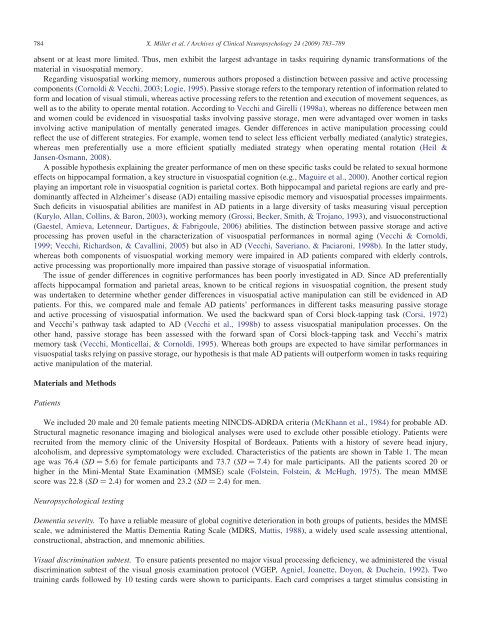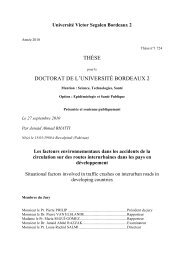Télécharger le texte intégral
Télécharger le texte intégral
Télécharger le texte intégral
Create successful ePaper yourself
Turn your PDF publications into a flip-book with our unique Google optimized e-Paper software.
784 X. Mil<strong>le</strong>t et al. / Archives of Clinical Neuropsychology 24 (2009) 783–789absent or at <strong>le</strong>ast more limited. Thus, men exhibit the largest advantage in tasks requiring dynamic transformations of thematerial in visuospatial memory.Regarding visuospatial working memory, numerous authors proposed a distinction between passive and active processingcomponents (Cornoldi & Vecchi, 2003; Logie, 1995). Passive storage refers to the temporary retention of information related toform and location of visual stimuli, whereas active processing refers to the retention and execution of movement sequences, aswell as to the ability to operate mental rotation. According to Vecchi and Girelli (1998a), whereas no difference between menand women could be evidenced in visuospatial tasks involving passive storage, men were advantaged over women in tasksinvolving active manipulation of mentally generated images. Gender differences in active manipulation processing couldref<strong>le</strong>ct the use of different strategies. For examp<strong>le</strong>, women tend to se<strong>le</strong>ct <strong>le</strong>ss efficient verbally mediated (analytic) strategies,whereas men preferentially use a more efficient spatially mediated strategy when operating mental rotation (Heil &Jansen-Osmann, 2008).A possib<strong>le</strong> hypothesis explaining the greater performance of men on these specific tasks could be related to sexual hormoneeffects on hippocampal formation, a key structure in visuospatial cognition (e.g., Maguire et al., 2000). Another cortical regionplaying an important ro<strong>le</strong> in visuospatial cognition is parietal cortex. Both hippocampal and parietal regions are early and predominantlyaffected in Alzheimer’s disease (AD) entailing massive episodic memory and visuospatial processes impairments.Such deficits in visuospatial abilities are manifest in AD patients in a large diversity of tasks measuring visual perception(Kurylo, Allan, Collins, & Baron, 2003), working memory (Grossi, Becker, Smith, & Trojano, 1993), and visuoconstructional(Gaestel, Amieva, Letenneur, Dartigues, & Fabrigou<strong>le</strong>, 2006) abilities. The distinction between passive storage and activeprocessing has proven useful in the characterization of visuospatial performances in normal aging (Vecchi & Cornoldi,1999; Vecchi, Richardson, & Cavallini, 2005) but also in AD (Vecchi, Saveriano, & Paciaroni, 1998b). In the latter study,whereas both components of visuospatial working memory were impaired in AD patients compared with elderly controls,active processing was proportionally more impaired than passive storage of visuospatial information.The issue of gender differences in cognitive performances has been poorly investigated in AD. Since AD preferentiallyaffects hippocampal formation and parietal areas, known to be critical regions in visuospatial cognition, the present studywas undertaken to determine whether gender differences in visuospatial active manipulation can still be evidenced in ADpatients. For this, we compared ma<strong>le</strong> and fema<strong>le</strong> AD patients’ performances in different tasks measuring passive storageand active processing of visuospatial information. We used the backward span of Corsi block-tapping task (Corsi, 1972)and Vecchi’s pathway task adapted to AD (Vecchi et al., 1998b) to assess visuospatial manipulation processes. On theother hand, passive storage has been assessed with the forward span of Corsi block-tapping task and Vecchi’s matrixmemory task (Vecchi, Monticellai, & Cornoldi, 1995). Whereas both groups are expected to have similar performances invisuospatial tasks relying on passive storage, our hypothesis is that ma<strong>le</strong> AD patients will outperform women in tasks requiringactive manipulation of the material.Materials and MethodsPatientsWe included 20 ma<strong>le</strong> and 20 fema<strong>le</strong> patients meeting NINCDS-ADRDA criteria (McKhann et al., 1984) for probab<strong>le</strong> AD.Structural magnetic resonance imaging and biological analyses were used to exclude other possib<strong>le</strong> etiology. Patients wererecruited from the memory clinic of the University Hospital of Bordeaux. Patients with a history of severe head injury,alcoholism, and depressive symptomatology were excluded. Characteristics of the patients are shown in Tab<strong>le</strong> 1. The meanage was 76.4 (SD ¼ 5.6) for fema<strong>le</strong> participants and 73.7 (SD ¼ 7.4) for ma<strong>le</strong> participants. All the patients scored 20 orhigher in the Mini-Mental State Examination (MMSE) sca<strong>le</strong> (Folstein, Folstein, & McHugh, 1975). The mean MMSEscore was 22.8 (SD ¼ 2.4) for women and 23.2 (SD ¼ 2.4) for men.Neuropsychological testingDementia severity. To have a reliab<strong>le</strong> measure of global cognitive deterioration in both groups of patients, besides the MMSEsca<strong>le</strong>, we administered the Mattis Dementia Rating Sca<strong>le</strong> (MDRS, Mattis, 1988), a widely used sca<strong>le</strong> assessing attentional,constructional, abstraction, and mnemonic abilities.Visual discrimination subtest. To ensure patients presented no major visual processing deficiency, we administered the visualdiscrimination subtest of the visual gnosis examination protocol (VGEP, Agniel, Joanette, Doyon, & Duchein, 1992). Twotraining cards followed by 10 testing cards were shown to participants. Each card comprises a target stimulus consisting in
















